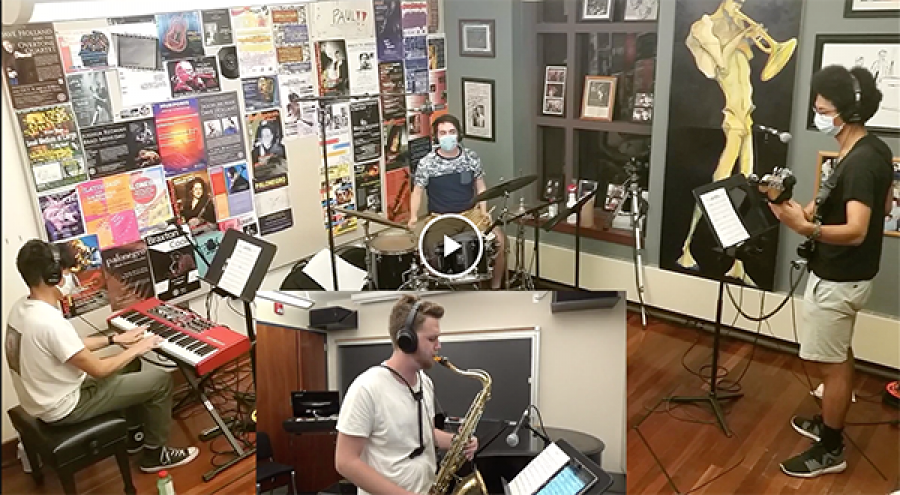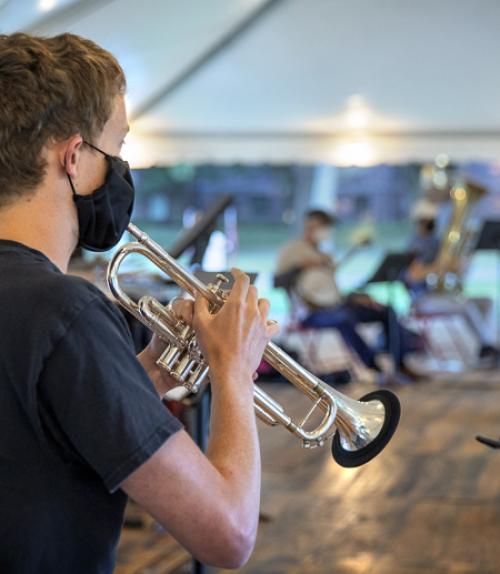For faculty members in the Department of Music, a return to campus made for difficult choices – would it be possible to create music together while safely socially distancing? Or would they need to devise other ways to help their students make music a part of their lives without being together in large ensembles?
Samantha Rubin ’23, was one of the many student musicians who wondered what this semester might bring.
“I play the saxophone, so it’s impossible for me to wear a mask while playing, and the air I breathe out inevitably spreads around the room as I play,” she said. “I thought the only way for me to play in a jazz combo this semester would be to have everyone recording their parts independently and stitching them together.”
But after considering a number of factors, professors decided on a multitude of creative approaches – some involving in-person smaller outside rehearsals, new networked inside spaces and an earlier-than-usual outdoor concert, while others involved Zoom-only meetings and a change in focus.
“I spent the summer constantly thinking of various scenarios and contingencies, and keeping an eye on independent studies focused on wind instrumentalists, singers and aerosol transmission,” said James Spinazzola, the Barbara and Richard T. Silver ’50, MD ’53 Assistant Professor and director of Cornell’s wind ensemble program. “What it came down to was that outdoor performance was the only option at this point.”
So, if you’re walking across the Arts Quad, you’ll see the open-sided tent with a wooden floor, where 36 students can gather safely to rehearse wearing special masks designed for musicians and using covers over the ends of their instruments. The ensemble is planning an outdoor concert for Oct. 17, hopefully in front of a live audience spread on the quad, but also recorded for people off campus.
"All the precautions make me feel more confident that it’s safe to come to rehearsal, and they don’t affect my playing much," said James Parker '21. "The big downside is that, since we’re rehearsing outdoors, we have to deal with the wind. It causes our music to flutter if not pinned down well, and many of us have to contort ourselves to keep our stands from falling over… But if that’s the only real price we pay, I’m OK with it."
An additional 15 students are participating online only and making music using a new version of JackTrip opensource software, which was designed from the ground up by Parker and another wind symphony member Alex Coy ‘21. JackTrip enables online music-making and improves the latency problem that exists with most current applications. The app could allow students to play together after the tent closes for the winter.
“My goal was to engage as many students as possible,” Spinazzola said. “If they’re not making music, their skills can disappear so quickly.”
After the concert, the ensemble will move to online instruction only, spending their time exploring the Vodou music and culture of Haiti through a series of virtual lectures. If this had been a regular year, the ensemble would have been heading to Haiti in January, a country they’ve visited twice in the past six years.
Along with their lectures, students will continue to practice individually and Spinazzola has compiled a listening list for students to discover new works.
"The wind symphony is extremely important to my Cornell experience," said Jess Sakamoto '22. "Playing music, working with others, receiving critical instruction, and performing are all things I value individually and that the wind symphony provides all at once."
For Chris Younghoon Kim, associate professor of music and director of Cornell orchestras, the decision to not meet in person this semester came down to issues of safety and equity.
In Zoom calls with his students over the summer, Kim discussed various options and noted a strong desire among students for action related to racial injustice, so he saw an opening for a semester-long focus.
“My students wanted to draft a statement related to Black Lives Matter, but I thought if we’re going to do something, I don’t want it to be an empty statement that doesn’t change the way our orchestra functions,” he said. “There is a systemic problem with orchestras as institutions.”
So, this semester his students are hearing from 12 artists, musicians, composers and activists about issues of inequity and racism in American orchestras, speakers such as Rachel Barton Pine, a violinist advocating for change for more than two decades and Aaron Dworkin, founder of the Sphinx Competition to encourage Black and Latinx instrumentalists. A.D. White Professor-at-Large Wynton Marsalis, Pulitzer and Grammy-winning trumpeter, will close out the speaker series Dec. 16. The speaker series is supported by an Engaged Curriculum Grant from the Office of Engagement Initiatives and Cornell’s student activities fund.
“We are talking about how we can become better musicians and also tackle one of the biggest problems of our generation,” Kim said. “It is not OK to just go back to playing the Western canon of music and the masterworks.”
Kim has also programmed four pieces of music that orchestra members are working with online, pieces such as Frederic Rzewski’s “Les Moutons de Panurge” that are aleatory and improvisational, not requiring students to be in sync with each other.
For students involved in CU Jazz, Paul Merrill, senior lecturer and the Herbert Gussman Director of Jazz, stretched his skills in sound engineering as he networked numerous practice rooms in Lincoln Hall so that students could play in small groups, but work together.
“We are using tech that is commonly found in large studios, concert halls and theaters and adapted it to meet our unusual needs as a jazz program,” Merrill said. “My Lincoln office now looks like a traditional studio, a place where a rhythm section of piano, bass and drums can perform and record.”
Three more Lincoln Hall rooms were equipped as sub-studios, with wind performers physically isolated from the other musicians. “This makes it possible for a trombonist, saxophonist or flautist to participate with little to no danger of aerosol transmission,” Merrill said. “With three pods and one studio, we are able to safely make music with a group of six musicians, a perfect size for a jazz combo.”
Stephen Chin ’21 said he misses the chance to be in the same room with his entire group, because things like physical motions and eye contact are so important in a style like jazz, where musicians often improvise. Even with the low latency, it’s sometimes still hard to stay together on faster-paced pieces.
But “overall, I'm always excited just to be able to play together with other people again. Any issues I have are pretty small compared to being able to continue making music, when I thought might not be possible,” Chin said.
Merrill is thankful for expertise and equipment lent by Kevin Ernste, associate professor of music, and the Electroacoustic Music Center. He also relied on Warren Cross, senior lecturer in performing and media arts and Chuck Raniewicz of Cornell Information Technologies for software help and on his colleague Kim, who donated his teaching studio as one of the three pods.
“For me, CU Jazz has always been about community. I’ve met students and teachers with whom I can discuss the intricacies of music theory, old and new albums from a variety of genres, and advice about how we can all improve as musicians,” said Paco Rilloraza ’21. “That sense of community was compromised by the pandemic, since being able to play music with other people is such a visceral and unmatched mode of communication. So having the opportunity to approximate that right now -- playing at the same time, but not necessarily in the same room -- has been incredibly cathartic.”
The new tech is allowing the student musicians to livestream and record content. CU Jazz plans to release performances on the Cornell Jazz YouTube channel, Cornell Music Facebook page and on the CU Jazz website. A group of jazz musicians also created an original piece for the College’s Oct. 8 reading of “The Bluest Eye,” part of the Arts Unplugged series.







